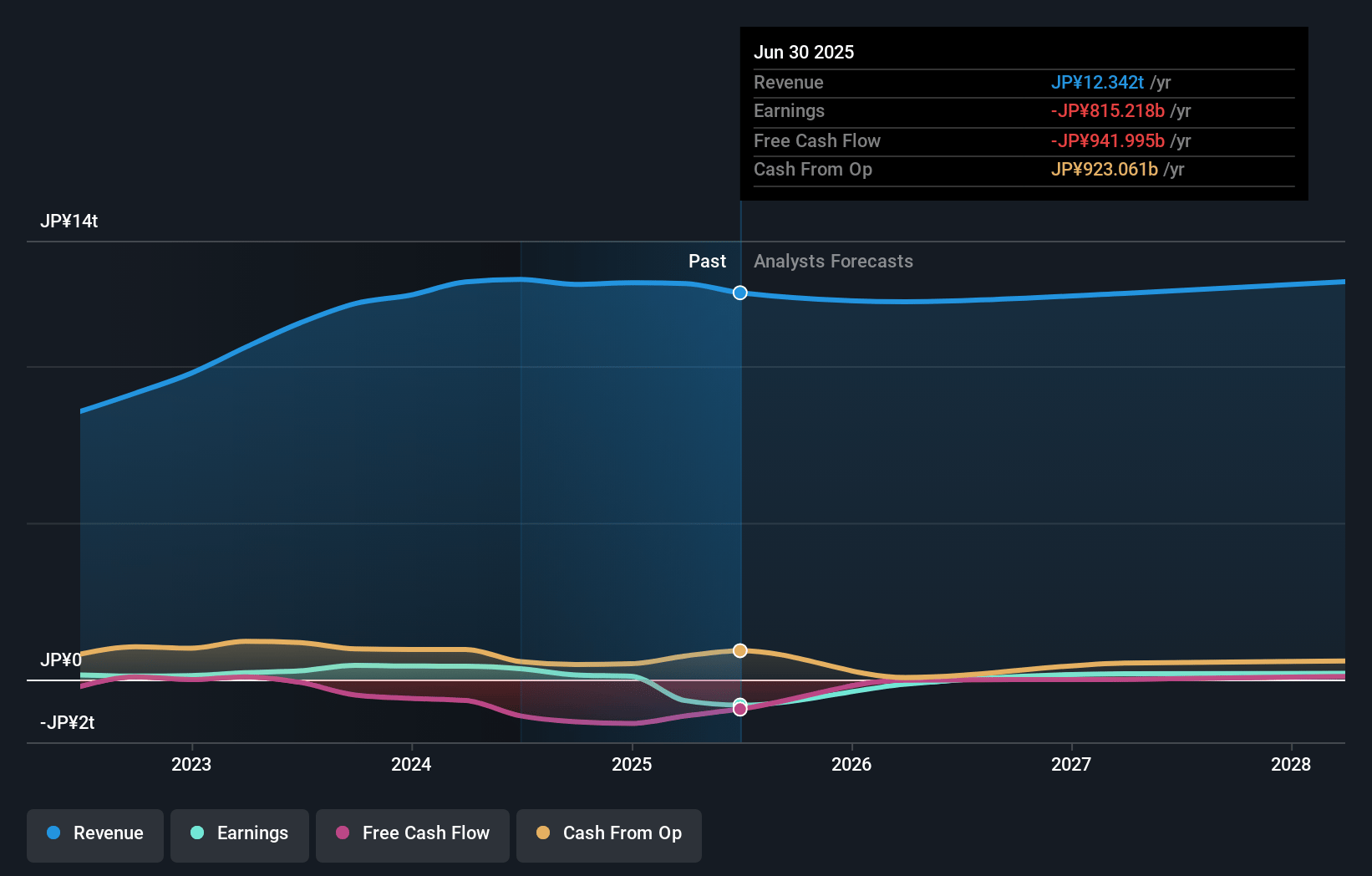Key Takeaways
- Initiatives to cut costs and streamline operations, including factory closures, aim to enhance profitability and operational efficiency.
- Strengthened product offerings in new energy and e-POWER technology could drive higher future earnings and new revenue opportunities.
- Strategic misalignments, declining sales, high costs, and restructuring efforts present challenges for Nissan's revenue growth and profitability.
Catalysts
About Nissan Motor- Manufactures and sells vehicles and automotive parts worldwide.
- Nissan's plans to introduce competitive new products and create new revenue opportunities toward 2026 could lead to increased revenue, even as they face challenges like CO2 emission regulatory costs.
- The company's focus on reducing fixed costs by ¥300 billion and variable expenses by ¥100 billion to achieve a 4% operating margin by 2026 could positively impact net margins.
- Streamlining operations and reducing headcount by 9,000 globally, including the closure of three factories, is expected to enhance operational efficiency and profitability.
- Strengthened product offerings, particularly with new energy vehicles and advancements in e-POWER technology, may contribute to higher future earnings.
- Nissan's ongoing efforts to explore strategic partnerships beyond the terminated integration with Honda could open new avenues for growth and financial improvement.
Nissan Motor Future Earnings and Revenue Growth
Assumptions
How have these above catalysts been quantified?- Analysts are assuming Nissan Motor's revenue will grow by 2.5% annually over the next 3 years.
- Analysts assume that profit margins will increase from 0.8% today to 1.8% in 3 years time.
- Analysts expect earnings to reach ¥244.5 billion (and earnings per share of ¥69.6) by about April 2028, up from ¥106.4 billion today. However, there is a considerable amount of disagreement amongst the analysts with the most bullish expecting ¥390.0 billion in earnings, and the most bearish expecting ¥37.0 billion.
- In order for the above numbers to justify the analysts price target, the company would need to trade at a PE ratio of 6.7x on those 2028 earnings, down from 10.8x today. This future PE is lower than the current PE for the JP Auto industry at 7.1x.
- Analysts expect the number of shares outstanding to decline by 6.17% per year for the next 3 years.
- To value all of this in today's terms, we will use a discount rate of 10.91%, as per the Simply Wall St company report.
Nissan Motor Future Earnings Per Share Growth
Risks
What could happen that would invalidate this narrative?- Termination of the MOU for business integration with Honda could indicate a lack of strategic synergy or alignment issues, leading to missed opportunities for cost-saving synergies and market growth, potentially limiting revenue and earnings growth.
- Nissan reported declining global retail sales, particularly in China, and weak performance in Japan and Europe, which could impact revenue and operating profit negatively.
- The company's operating profit and net income have decreased, with net revenue remaining flat, suggesting potential inefficiencies or external pressures affecting margins and earnings.
- High marketing expenses and a negative impact from inflation and sales performance suggest ongoing cost management issues, which could weigh on net margins.
- Planned headcount reductions and plant closures indicate significant restructuring efforts that carry execution risks and potential short-term disruptions to production capacity and revenue.
Valuation
How have all the factors above been brought together to estimate a fair value?- The analysts have a consensus price target of ¥392.0 for Nissan Motor based on their expectations of its future earnings growth, profit margins and other risk factors. However, there is a degree of disagreement amongst analysts, with the most bullish reporting a price target of ¥638.0, and the most bearish reporting a price target of just ¥250.0.
- In order for you to agree with the analyst's consensus, you'd need to believe that by 2028, revenues will be ¥13638.6 billion, earnings will come to ¥244.5 billion, and it would be trading on a PE ratio of 6.7x, assuming you use a discount rate of 10.9%.
- Given the current share price of ¥311.5, the analyst price target of ¥392.0 is 20.5% higher.
- We always encourage you to reach your own conclusions though. So sense check these analyst numbers against your own assumptions and expectations based on your understanding of the business and what you believe is probable.
How well do narratives help inform your perspective?
Disclaimer
Warren A.I. is a tool utilizing a Large Language Model (LLM) that ingests data on consensus price targets, forecasted revenue and earnings figures, as well as the transcripts of earnings calls to produce qualitative analysis. The narratives produced by Warren A.I. are general in nature and are based solely on analyst data and publicly-available material published by the respective companies. These scenarios are not indicative of the company's future performance and are exploratory in nature. Simply Wall St has no position in the company(s) mentioned. Simply Wall St may provide the securities issuer or related entities with website advertising services for a fee, on an arm's length basis. These relationships have no impact on the way we conduct our business, the content we host, or how our content is served to users. The price targets and estimates used are consensus data, and do not constitute a recommendation to buy or sell any stock, and they do not take account of your objectives, or your financial situation. Note that Warren A.I.'s analysis may not factor in the latest price-sensitive company announcements or qualitative material.




